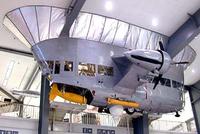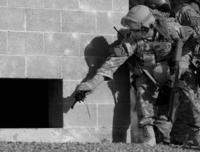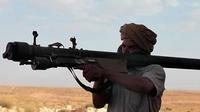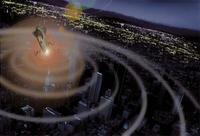-
Brazilian fern inspires waterproof coating
A floating weed that clogs waterways around the world has at least one redeeming feature: it has inspired a high-tech waterproof coating intended for boats and submarines
-
-
Researchers fire 1,000th shot on laboratory railgun
Scientists reached a milestone in the Electromagnetic Railgun program when they fired a laboratory-scale system for the 1,000th time on 31 October, the raygun is a long-range weapon that launches projectiles using electricity instead of chemical propellants
-
-
U.S. Army to deploy “kamikaze” drones
The U.S. Army is getting ready to add a “kamikaze drone” to its arsenal; the new drone is designed to hover quietly in the sky before it dive-bombs directly into a human target
-
-
Laser Energetics delivers Dazer Laser GUARDIAN
Mercerville, New Jersey-based Laser Energetics, Inc. has announced the delivery of their Dazer Laser GUARDIANS; the initial delivery was made yesterday
-
-
U.A. Navy sees blimp come-back

In 1962, after forty-seven years, the U.S. Navy effectively terminated Lighter-Than-Air (LTA) operations; but the blimp is making a come-back, and on 26 October, the Naval Air Warfare Center Aircraft Division and the U.S. Naval Research Laboratory unveiled the MZ-3A airship; for now, it is the only manned airship in the U.S. Navy’s inventory
-
-
Army Reserve could soon take on homeland security missions

The House and the Senate are currently debating legislation that would allow the Army Reserve to be deployed for homeland security missions
-
-
Innovative surveillance solutions recognized
MicroObserver Unattended Ground Sensor from Textron Defense Systems was recognized as one of the 2011 Big 25 intelligence, surveillance, and reconnaissance (ISR) products; the solution detects and tracks vehicles and personnel for perimeter defense, border security, force protection, persistent surveillance, and critical infrastructure protection
-
-
Flight control software helps pilots stick carrier landings

Navy and Marine Corps aviators conducting carrier landings today line up with a moving flight deck in a complicated process; they must constantly adjust their speed and manipulate the aircraft’s flight control surfaces — ailerons, rudders, and elevators — to maintain the proper glide path and alignment to the flight deck for an arrested landing; new software makes landing much easier
-
-
Army contracting scandal reaches DHS
A $20 million contracting scandal involving the Army Corps of Engineers has now grown to include DHS; last week, Representative Edward J. Markey (D-Massachusetts) expanded the congressional probe to gather information on EyakTek, an Alaskan-native corporation that has received more than $1 billion in set-aside contracts from DHS and the Army
-
-
Detecting criminals coming back to the scene of the crime
Law enforcement officials believe that perpetrators of certain crimes, most notably arson, do come back to the scene of the crime to witness their handiwork; similarly, U.S. military in the Middle East feel that improvised explosive device (IED) bomb makers return to see the results of their work in order to evolve their designs; scientists have developed a method to identify these individuals
-
-
Innometrik, Lumidigm integrate technologies
Lumidigm says that Innometriks’ Rhino reader, which combines embedded Lumidigm fingerprint biometrics, smart cards, PKI, and digital signature technologies, is now handling high security applications in extreme weather and rough environments for several organizations of the U.S. Department of Defense
-
-
U.S. army orders 315 reconnaissance micro-robots

Recon Scout XT weighs 1.2lbs (540g), can be deployed in five seconds, and thrown up to 120 feet (36m); soldiers and law enforcement use the Recon Scout system to determine the layout of the enclosed spaces, identify potential IEDs, and the fix the location of friendly, indigenous, or enemy personnel
-
-
NATO: 10,000 Libyan shoulder-fired missiles unaccounted for

Senior NATO officials said that at least 10,000 shoulder-fired anti-aircraft missiles are unaccounted for in Libya, and that at least some of them may have fallen in the hands of al Qaeda operatives; the missiles are known as SAM-7 by NATO designation and 9K32 Strela-2 in Russia, and typically have a range of about four kilometers and an infra-red guidance system; more than forty civilian aircraft have been hit by these portable surface-to-air missiles since 1975, causing about twenty-eight crashes and more than 800 deaths around the world
-
-
Nonlethal microwave weapon successfully tested

Counter-electronics High-powered Microwave Advanced Missile Project (CHAMP) is a nonlethal alternative to kinetic weapons that neutralizes electronic targets; it would allow the military to focus on these targets while minimizing or eliminating collateral damage; Boeing and the U.S. Air Force have successfully completed the missile’s first flight test
-
-
U.S. Army buys Raptor's MIPs-based detectors

Molecularly imprinted polymers (MIPs) technology is capable of selectively sensing microscopic amounts of explosives or other molecules that are dangerous for humans and the environment, such as toxins, chemical agents, biological agents, pesticides, and poisons; the U.S. Army wants more MIPs detectors
-
More headlines
The long view
Bookshelf: Smartphones Shape War in Hyperconnected World
The smartphone is helping to shape the conduct and representation of contemporary war. A new book argues that as an operative device, the smartphone is now “being used as a central weapon of war.”
